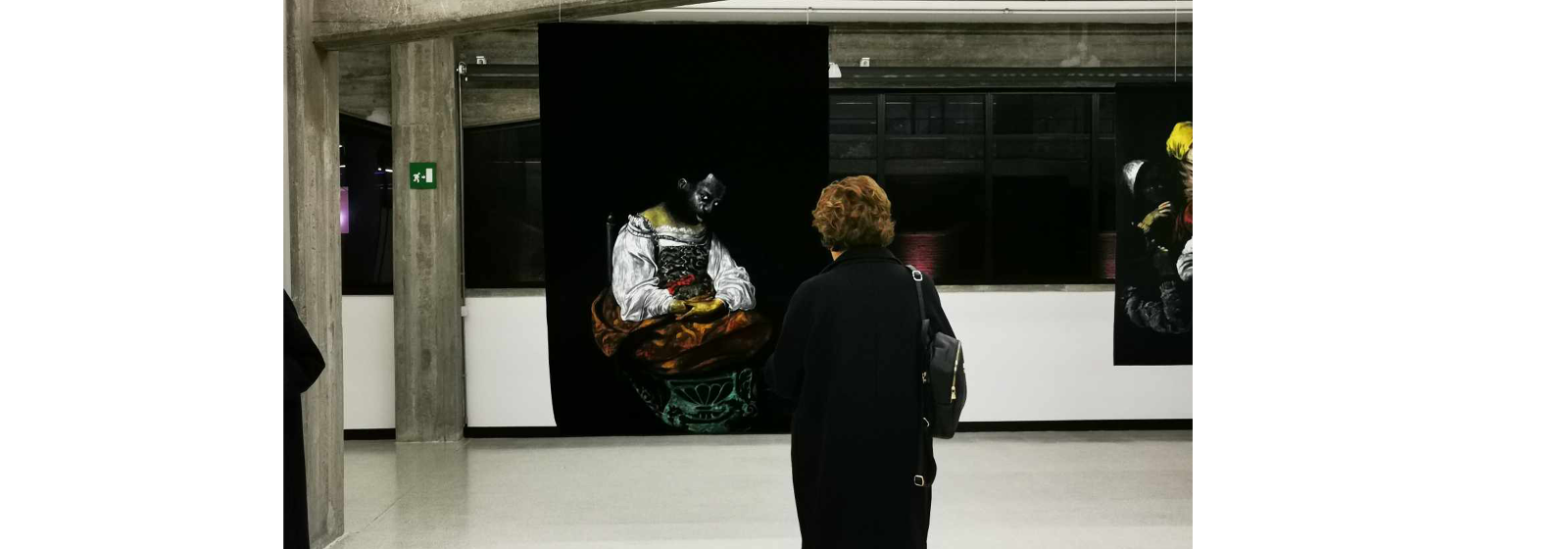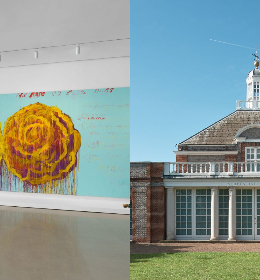The spirit of the place is hard to ignore. In 1957, the Max Mara factory was built in Reggio Emilia, a city in northern Italy known for its strong anti-fascist legacy and its active support for the anti-apartheid movement in South Africa. This is where Achille Maramotti established his collection in 2007, a space that now houses the work of the Franco-Beninese painter Roméo Mivekannin.

Roméo Mivekannin, D’après La couleur de la grenade, Sergueï Paradjanov (1969), 2024. © Roméo Mivekannin, by SIAE 2025. Courtesy of the artist and Galerie Cecile Fakhoury. Photo: Gregory Copitet.
With "Black Mirror", Mivekannin questions the construction of historical narratives and the mechanisms that render certain figures invisible. For the first time, the artist experiments with velvet painting, a medium that absorbs not only colour and light, but also the viewer's gaze until it is fully immersed.
Influenced by the time he spent in this brutalist building, surrounded by the works of the Collezione Maramotti, including those of Gerhard Richter and Francis Bacon, Mivekannin revisits Masaccio, Caravaggio, or Goya, through a personal and political lens. His choice of black inverts the traditional pictorial process: everything emerges from the shadows. "Black Mirror" blurs our certainties. The artwork, and Mivekannin himself, whose face surfaces from the velvet, scrutinise us as we observe, stirring discomfort or revelation.

Roméo Mivekannin, D’après Holy Motors, Léos Carax (2012), 2024. © Roméo Mivekannin, by SIAE 2025. Courtesy of the artist and Galerie Cecile Fakhoury. Photo: Gregory Copitet.

Roméo Mivekannin, D’après Le crucifiement de Saint Pierre, Le Caravage (1600), 2024. © Roméo Mivekannin, by SIAE 2025. Courtesy of the artist and Galerie Cecile Fakhoury. Photo: Gregory Copitet.
One of the artist's signatures is this reappropriation of his own face, which he inserts insistently into that of marginalised or historically sidelined figures. His omnipresent self-portrait allows him to embody these characters and introduce himself into the narrative as a powerful and ghostly subject. His gaze challenges the observer, reversing the compositional hierarchies and upsetting power dynamics. His works question the construction and erasure of memory, and explore the relationship between history, the sacred, and collective identity.

Roméo Mivekannin, D’après Salò ou les 120 Journées de Sodome, Pier Paolo Pasolini (1975), 2024. © Roméo Mivekannin, by SIAE 2025. Courtesy of the artist and Galerie Cecile Fakhoury. Photo: Gregory Copitet.

Roméo Mivekannin, D’après Jésus et les docteurs, Théodule Ribot (1879), 2024. © Roméo Mivekannin, by SIAE 2025. Courtesy of the artist and Galerie Cecile Fakhoury. Photo: Gregory Copitet.
For the Collezione Maramotti, Mivekannin has created a series of twenty paintings on black velvet, fully aligned with his iconographic universe yet enriched by the impressions gathered during his time in Emilia-Romagna and his conversations with the region’s artistic and cultural scene. "Black Mirror" is more than a tribute to painting; it invokes cinema, cinema, dance, theatre, drawing on Pasolini, Pina Bausch, or Paradjanov.

Exhibition view. Roméo Mivekannin, “Black Mirror”. Collezione Maramotti, Reggio Emilia. © Roméo Mivekannin, by SIAE 2025. Courtesy of the artist and Galerie Cecile Fakhoury. Photo: Roberto Marossi.
The Collezione Maramotti is designed as a space for dialogue. By reversing the dynamics of the gaze and deconstructing memory, Mivekannin doesn't simply revisit art history: he challenges the viewer’s position to the images. "Black Mirror" unsettles, opens breaches. This is not art to be passively admired, it challenges and interrogates us.
"Black Mirror" is on display at the Collezione Maramotti until 28 July 2025.









